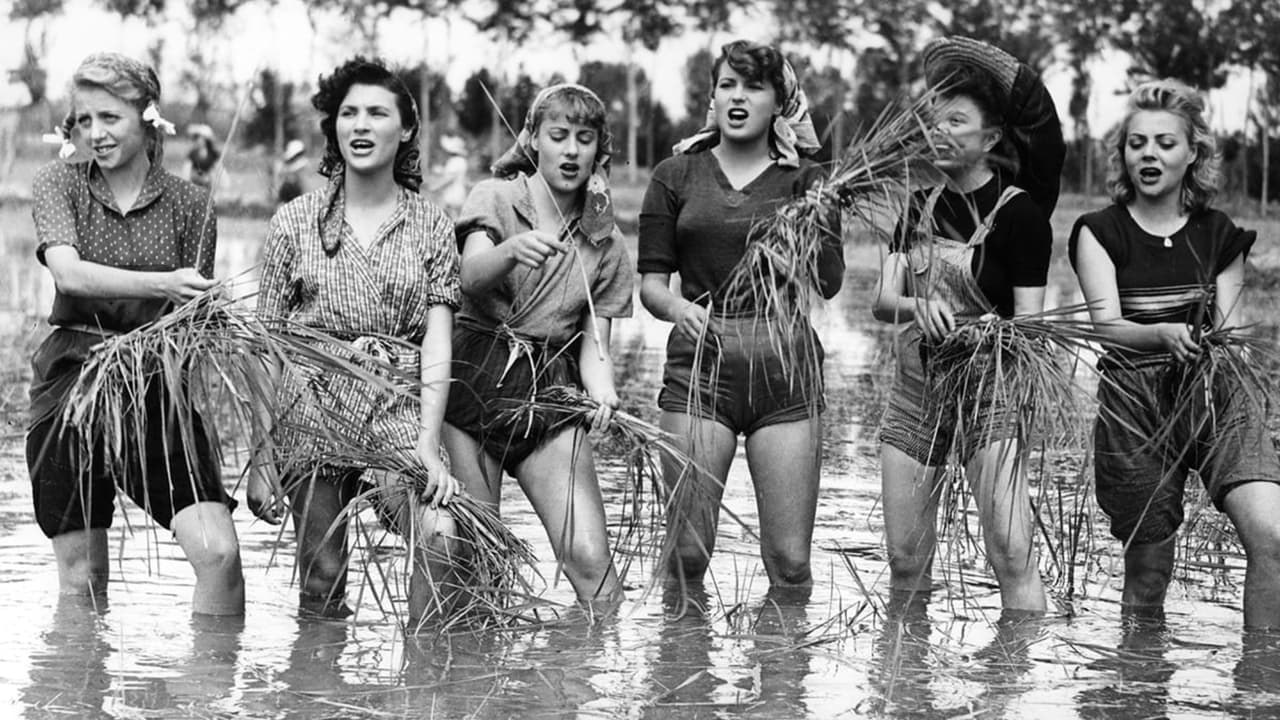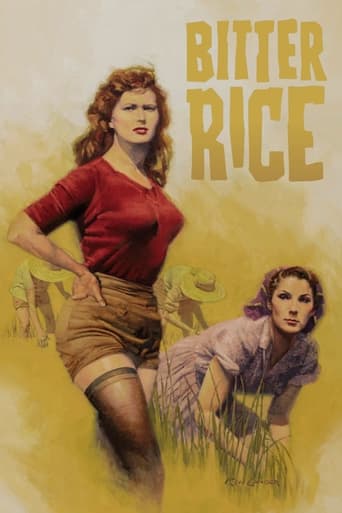

Not copyright 1948 by Lux Films. New York opening in a sub-titled version at the World: 18 September 1950. U.S. release through Lux Films (sub-titled version) on 21 September 1950 and through Italian Films Export (dubbed version) in 1952. London opening of the sub- titled version at the Rialto, around March 1950. U.K. release of this version through Gelardi, Rashbrooke. Australian release in an English-dubbed version by RKO Radio Pictures: 7 March 1952. Sydney opening at the Esquire. Running times: 112 minutes (Australia), 103 minutes (London), 107 minutes (New York), 93 minutes (U.S. dubbed version).Original Italian title: RISO AMARO.NOTES: Giuseppe de Santis and Carlo Lizzani were nominated for the 1950 Academy Award for Best Motion Picture Story, losing to "Panic in the Streets."COMMENT: Italian films of the forties and early fifties always pose a bit of an aural dilemma for me. I mean the dubbing. On the whole, I have a preference for the English-dubbed version because in most cases the British or American stars post-sync their own voices, whereas in the Rome version, none of the players — aside from the really big stars like Anna Magnani, Gino Cervi and Amedeo Nazzari — are allowed anywhere near a microphone. It's strange to hear Vittorio Gassman's distinctively throaty voice replaced by a bland radio actor's; and equally disconcerting to find Silvana's peasant girl speaking beautifully cultured high class.Of course, "Bitter Rice" was such a sensational success, it launched not only Mangano, but Gassman and Vallone as well, on to the international scene. Gassman was offered a Hollywood contract and before long was co-starring opposite the likes of Elizabeth Taylor. Mangano continued her career after marrying this film's producer in 1949. Incidentally, "Bitter Rice" was not her first film. She'd previously made L'elisir d'amore for director Mario Costa in 1947. And she was eighteen, not seventeen, when she starred in Riso Amaro.Alas, the film did nothing for the waning career of that ultra- classy siren of "The Blue Dahlia", Doris Dowling. Forced to play second fiddle to Mangano, she's not only dowdily dressed but robbed of her distinctive voice.I thought the attempt to marry documentary neo-realism with a melodramatic plot worked rather well. The realistic backgrounds made the story seem far more credible, whilst at the same time the more sensational aspects of the story lend an added power and poignancy to the plight of the rice workers. The four leading characters are skillfully delineated. The writers give them enough quirks to make their behavior and reactions individualistic without descending into caricature.Director De Santis and photographer Martelli's probing camera explore the teeming settings to the full, assisted by a no-holds- barred budget and an appropriately atmospheric music score.
... View MoreThere's something about the way actress Doris Dowling stares piercingly into the eyes of the men and women who temporarily populate the Po Valley of northern Italy. Hardly a shrinking violet, the shrewdness she innately possesses drips from her sweated brow and subtle scowl. She's equal parts Barbara Stanwyck in Double Indeminity (1944) and Vivien Leigh in Streetcar (1951); both the criminal and the victim.Bitter Rice concerns the tragic entanglements of four people, two men and two women during the much celebrated time of the northern rice harvest circa 1949. Walter (Gassman) and Francesca (Dowling) are fugitives hiding from the fuzz with a thicket of stolen jewels. They find respite among the gaggle of women working the harvest and decide to stay just long enough to elude capture and steal a few bags of rice. The craven Walter finds himself attracted to a youthful rice weeder named Silvana (Mangano) who glamorizes trinkets of American largess including and especially pop music. As such, she immediately becomes drawn to Walter's bad-boy persona. Meanwhile Marco (Vallone) a disaffected war veteran attempts to court Silvana but finds conflict from all angles.The film is a jumble of compromised pastiche, referencing everything from pre-code crime and social problem films to stage musicals adapted to the screen. Yet it's all translated with neo-realist cinematography and wing-clipped melancholia. The love triangle for instance leaves the impression of a screwball comedy yet any humor or sexual tension is muted when compared to the paranoia shared by our two criminal leads. That very real tension is subsequently switched out with flashes of turf-war bravado pre-dating the American "teen" movies of the decade to come. There's an argument to be made that this quixotic mix of sensibilities amplifies the pettiness with which our characters seem doomed to repeat again and again. What's a girls obsession with American bubblegum when compared to the troubles of an army of harvesters working in the heat?Yet the way the movie gives equal weight to the melodrama as to the characterization keeps this film just out of place for the time; like bran of the grain just slightly askew. While constantly reminding its audience of the space, the time and the politics of the day, we don't see the characters as we should - tragic and vulnerable. Instead we see them petty, vain, and oafish; oblivious to their effect on the strangers that they harvest rice with. By combining the moral and economic difficulties of post-war Italy with western-style myopia there's certainly a pep to the plot but no characters to really root for.This tug-o-war between Italian neo-realism and Hollywood glitz and melodrama reaches its boiling point during the climax, which pits the four against each other in a slaughterhouse, under the cover of night. It's a mesmerizing scene that is brimming with symbolism, pathos, artful audience manipulation and suspense. Considered as a marriage of form and technique, the climax is a marvel though seen as a corruption, the film hammers home a deeply anti-consumerist message. One that not only highlights the seductive and prevalent nature of American-style capitalism but can even be seen as a commentary on Italy's 1948 General Election (which was seen by the west as a Cold War tipping point).Yet taken out of its political and historical context, Bitter Rice is at its heart a pulpy rural drama. One that can't help but be compared to films like The Big Sleep (1946) and lauded as the film that got Silvana Mangano on the fast track to international stardom. Yet despite its limitations, the image of Doris Dowling's fierce, icy glare is burned into memory and should be etched into cinematic consciousness in the same way Mangano's erotic boogie-woogie is.
... View MoreAlong a few weeks in Northern Italy, many women leave their families and jobs and move to the rice fields to work in the harvest of rice. The lovers Francesca (Doris Dowling) and Walter (Vittorio Gassman) has just robbed a valuable jewel from a hotel, and Francesca joins a group of workers while escaping from the police. A silly and sensual worker, Silvana (Silvana Mangano), gets closer to Francesca fascinated by the precious necklace she found hidden in Francesca's mattress. When they arrive to the lodge, they meet Sergeant Marco (Raf Vallone), who is discharging the army and feels attracted by Silvana. A square of love is formed with tragic consequences."Riso Amaro" is an original neo-realistic dramatic romance that presented Silvana Mangano to the world, leading her to a position of star. She is extremely beautiful and sexy in the role of the peasant Silvana, especially while dancing with the handsome Vittorio Gassman. Doris Dowling is also excellent, performing the suffering Francesca, a women abused by her scum lover. This movie was presented in the fourth Cannes Festival, without awards. My vote is eight.Title (Brazil): "Arroz Amargo" ("Bitter Rice")
... View MoreIn the 1940s -early 1950s Italian Cinema was at it peak. neo-realism was the stlye The Great Italian Directors came of age: De Sica/Fellini/DeSantis & others the italian movie actresses came in to being :Magnani/Lollabridgida/Loren /Martinelli and most especially here SYLVANA MANGANO.. sultry/earthy/sexy/beautiful/tempestuous etc.. she & her directors created images which one cannot forget!!The scene in Bitter Rice where she dances solo has to rate with anything Rita Hayorth or Marilyn Monroe did in Hollywood!!wow exciting, sensuous & memorable; as a film ,Bitter Rice ,is a fine example of Italian films of that era.. an exciting depiction of working class Italy & the problems that they endured@ 1940s....So well done with a fine cast Raf Vallone/Vittorio Gassman & American film actress Doris Dowling in a memorable role as Francesca.. the scenes in the rice field with the working women are most effective for me..The plot gets a bit melodramatic with multiple shootings etc at end, & Manganos great suicide scene.. However her finest moment is in the rice field , in the rain, when she is raped(seduced) by the leacherous Walter (Gassmann) her reaction to that moment is incredible!! Great to see again & again !!
... View More